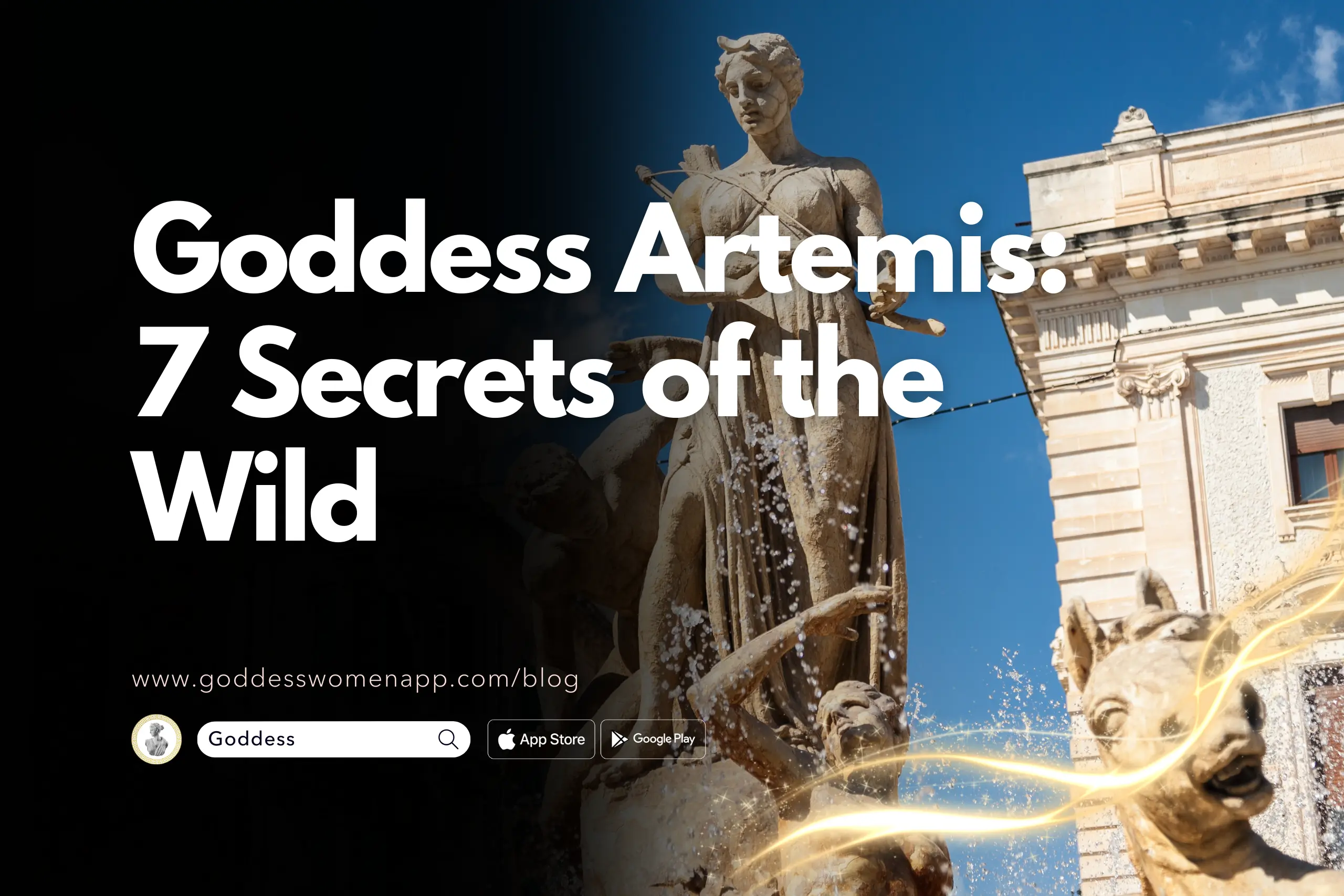Table of Contents
Introduction: Unveiling the Mysteries of Artemis
In the pantheon of ancient Greek deities, Goddess Artemis occupies a unique and revered position. Known to the Romans as Diana, Artemis, the Greek Goddess of the hunt, wild animals, childbirth, and virginity, stands as a figure of independence and strength. Her origins, deeply rooted in Greek mythology, paint a picture of a deity whose essence is as untamed as the wilderness she presides over. This article aims to delve into the enigmatic world of Artemis, uncovering the facets of her divinity and the profound impact she has had on ancient Greece and beyond.

The Birth of Artemis: The Dawn of Her Wild Domain
The story of Artemis’s birth is as fascinating as the goddess herself. Born to Zeus, the king of the Greek gods, and Leto, Artemis was the twin sister of Apollo, the god of the sun, music, and prophecy. Ancient texts recount how Leto, persecuted by the jealous queen of the gods, Hera, found refuge on the isle of Delos to give birth to her children. Artemis was born first, and in most accounts, she emerged as a fully-formed virgin huntress. Remarkably, she then assisted her mother in giving birth to her twin brother, Apollo, showcasing her association with childbirth and the protection of the young and vulnerable from her very inception.
Artemis’s childhood is woven with stories that highlight her pre-Greek origin and her deep connection to the natural world and its wild nature. From an early age, she was granted by her father, Zeus, a golden bow and arrows, symbolizing her mastery over hunting and her role as the protector of animals and the wilderness. Unlike other Greek gods and goddesses, Artemis was known to roam the forests with her hunting dogs and a band of nymphs, embodying the spirit of the virgin huntress, untamed and fiercely autonomous.
Artemis’s sacred domain was not just confined to the forests and mountains of ancient Greece but also encompassed the hearts of the rural populace, who revered her as the mistress of animals and the guardian of their communities. Temples dedicated to Artemis, like the famous Temple of Artemis Orthia, served as centers of worship, where ancient Greeks would offer sacrifices to seek her favor and protection. Her influence extended to the arts as well, with numerous marble statues and works of Roman art depicting her as a formidable figure, armed with her bow and accompanied by her loyal hunting dogs.

In Greek legend, Artemis’s wrath was as well-known as her benevolence. Stories tell of the goddess transforming individuals who crossed her into wild animals or even killing those who threatened her sacred animals or insulted her purity. Yet, these tales also underscore her role as a guardian of innocence and defender of the natural world, emphasizing her complex character as both nurturer and warrior.
The birth of Artemis and her ensuing exploits illuminate the tapestry of Greek mythology with tales of courage, protection, and reverence for the wild. As we explore the secrets of Artemis, we uncover not just the history of a goddess but the ancient Greeks’ profound connection to the natural world and the divine. Artemis, with her golden bow, stands as a timeless symbol of untamed nature, a protector of the vulnerable, and a revered figure among the ancient Greek deities, whose legacy continues to enchant and inspire.
Goddess Artemis and Her Sacred Grove
In the heart of the ancient world, the sacred groves of Goddess Artemis stood as sanctuaries of wild nature and divine protection. These groves, scattered across ancient Greece, were not merely forests but sacred spaces where the boundary between the human and divine blurred. As a virgin goddess and the mistress of animals, Artemis’s groves were places of worship, where ancient Greeks sought her blessings for hunting, childbirth, and protection of the young.
The groves were alive with the presence of wild animals, symbolizing Artemis’s role as their guardian. Within these sacred spaces, marble statues and temples dedicated to Artemis, such as the famed Artemis Orthia, underscored her importance in Greek religion and mythology. The rural populace, in particular, held these groves in high esteem, viewing them as direct links to the divine protection of Artemis.

Artemis’s Companions: The Nymphs and Their Role
Accompanying Artemis in her wanderings and rituals were her loyal companions, the nymphs. These divine or semi-divine entities were not just mere followers but integral figures in the cult and mythology of Artemis. Serving as hunting companions, they mirrored Artemis’s virtues of chastity, independence, and strength. The role of the nymphs extended beyond the hunt; they were caretakers of the wilderness, guardians of sacred springs, and protectors of young girls, reflecting the goddess’s diverse roles.
Among these nymphs, stories of their dedication and loyalty to Artemis abound, highlighting their symbiotic relationship. In several myths, Artemis’s nymphs are depicted facing challenges and transformations, often as a result of protecting the goddess’s sanctity or ensuring the sanctity of her sacred spaces. These tales underscore the bond between Artemis and her nymphs, a relationship founded on mutual respect and the shared duty of guarding the wild and the innocent.
The sacred groves and nymph companions of Artemis illustrate her complex nature as both a nurturer and protector. They reveal how ancient Greeks conceived of their gods and goddesses not just as distant deities but as integral figures in the natural world and human life. Through worship in these groves and the tales of her loyal nymphs, Artemis’s influence extended beyond the realms of hunting and wild animals to encompass aspects of purity, protection, and communal welfare, making her worship among the most holistic in ancient Greek religion.

The Bow and Arrow: Symbols of Artemis’s Power
The bow and arrow are not merely weapons in the hands of Goddess Artemis; they are potent symbols of her strength, autonomy, and domain over the wild. Given to her by Zeus, her father, these golden instruments were bestowed upon Artemis during her childhood, marking her as the virgin huntress and protector of the natural world.
In Greek mythology, the bow and arrow represent Artemis’s ability to strike at a distance, emphasizing her role as a guardian and warrior. This imagery is vividly captured in Roman art and ancient Greek deities’ statues, where Artemis is often depicted with her bow drawn, ready to defend her sanctity and that of her followers.
The significance of these symbols extends beyond their martial aspect; they embody Artemis’s spiritual authority over life and death. As the mistress of animals and the goddess of wild nature, Artemis used her bow and arrow to both protect and provide, ensuring the balance of the ecosystems under her care. Her mastery of these tools highlights her independence, a trait highly valued among the rural populace of ancient Greece, who saw in Artemis a divine protector worthy of reverence and worship.
Protector of the Young and Vulnerable
Artemis’s role as a protector is most poignantly reflected in her guardianship over the young and vulnerable, a domain that extends from the forests and their inhabitants to human communities. As a virgin goddess, Artemis was particularly concerned with the protection of young girls, overseeing their transition into womanhood. This aspect of her divinity is celebrated in several Homeric hymns, where she is invoked as the guardian of maidens and the patroness of childbirth, highlighting her nurturing side.
The mythology surrounding Artemis is replete with tales of her intervention to save the vulnerable. From rescuing her own mother, Leto, as she gave birth to Artemis and her twin brother, Apollo, to defending her nymphs and sacred animals against those who would do them harm, Artemis’s wrath was feared by all who threatened the innocent. Her actions often served as a reminder of the natural and divine laws governing the ancient world, reinforcing her status among the Greek gods as a formidable protector and enforcer of justice.
Artemis’s dedication to the young and vulnerable was not limited to mythic tales; it was mirrored in the real-world practices of ancient Greece, where festivals and rites of passage celebrated her contributions to society. Through these practices, Artemis’s influence permeated the daily lives of the ancient Greeks, establishing her as a central figure in their religious and cultural landscape. As both the mistress of the hunt and the guardian of life’s beginnings, Artemis embodies the complexity and interconnectedness of existence, securing her place in the pantheon of ancient Greek deities as a powerful and compassionate goddess.

Artemis’s Wrath: Defending Her Sanctity
Artemis, the Greek goddess of the hunt and virginity, is often depicted as a paragon of purity and wild independence, a protector of the natural world and its inhabitants. However, her mythology is also steeped in tales of fierce wrath, meted out to those who dared to transgress her principles or threaten her sanctity or that of her followers. Among the pantheon of ancient Greek gods, Artemis’s retribution was feared, for she guarded her purity and the purity of her companions with unmatched ferocity.
One of the most famous legends illustrating Artemis’s wrath involves the hunter Actaeon. According to Greek mythology, Actaeon stumbled upon Artemis bathing in a sacred spring, and for this unintended transgression, Artemis transformed him into a stag. His own hunting dogs, unable to recognize their master, then tore him apart. This story, among others, served as a cautionary tale, highlighting the goddess’s fierce protection of her privacy and sacredness.

The Moon and Artemis: A Celestial Connection
The connection between Artemis and the moon is a pivotal aspect of her worship and iconography, casting her as a celestial deity in addition to her earthly dominions. As a twin sister of Apollo, the sun god, Artemis’s association with the moon creates a divine balance between night and day, reflecting the ancient Greeks’ observation of the natural world and its rhythms. This celestial connection emphasizes Artemis’s role as a goddess of transitions, illuminating the night for hunters and guiding women through childbirth.
In Roman art and Greek legend, Artemis is often depicted with the crescent moon, symbolizing her as the luminary of the night sky, overseeing the natural cycles that govern life on Earth. This connection to the moon also ties her to the ebb and flow of women’s lives, particularly in her capacity as a protector of childbirth and the young. Temples dedicated to Artemis, such as the Temple of Artemis Orthia, often played roles in rituals and ceremonies that celebrated these lunar influences, embodying the goddess’s dual nature as both a nurturer and a fierce defender.
Artemis’s association with the moon further highlights her as a mistress of animals, with the moon’s cycles influencing the behaviors of the wild animals she protected. This link between the celestial and the terrestrial underscores Artemis’s comprehensive domain over the natural world, from the forests and their creatures to the night sky itself.
Together, the stories of Artemis’s wrath and her connection to the moon weave a complex tapestry that illustrates the goddess’s multifaceted nature. She is at once the virgin huntress, a formidable protector, and a celestial deity, embodying the ancient Greeks’ reverence for the natural world and its inherent powers. Through her myths and worship, Artemis remains a symbol of purity, protection, and the indomitable spirit of the wild, revered across ancient Greece and beyond.

Artemis Today: Her Legacy in the Modern World
The legacy of Goddess Artemis, a figure emblematic of the wild, the protector of the young and the vulnerable, and a beacon of independence, transcends the confines of ancient Greece to resonate with the modern world. Her enduring influence is seen in various facets of contemporary culture, from the arts to environmentalism, embodying values and ideals that are as relevant today as they were thousands of years ago.
The Protector of Nature and Wildlife
Artemis’s connection to wild animals and untouched landscapes echoes in today’s growing environmental consciousness. As the ancient Greek goddess who roamed the forests with her hunting dogs and defended the sanctity of the natural world, Artemis symbolizes the urgent need to protect our planet’s biodiversity and wilderness areas. Environmental groups and conservationists often draw on imagery and qualities associated with Artemis, emphasizing the importance of stewardship and respect for wildlife and natural habitats.

Feminism and Female Empowerment
As a virgin goddess who was master of her own fate, Artemis represents strength, autonomy, and the rejection of traditional roles that restrict female freedom and potential. Her legacy inspires women and girls to embrace their power, stand up for their rights, and pursue their passions with courage and determination. Artemis’s refusal to conform to the expectations of other Greek gods and goddesses, choosing instead the company of her nymphs and the freedom of the wilderness, makes her a potent symbol for feminist movements and the ongoing struggle for gender equality.
Artemis in Art and Literature
The influence of Artemis extends into the realms of art and literature, where she is frequently depicted in Roman art, classical studies, and modern creative works. Her figure inspires artists and writers to explore themes of independence, nature, and the divine feminine. From marble statues that capture her ethereal beauty and strength to contemporary works that reinterpret her myths for a new audience, Artemis continues to be a muse for creative expression.
Worship and Spirituality
Though the ancient temples dedicated to Artemis, such as Artemis Orthia, no longer serve as centers of worship, the goddess’s spiritual legacy persists. Many who are drawn to the mythology and archetypes of ancient Greece find in Artemis a divine figure who resonates with their personal journey toward understanding the mysteries of life and the natural world. Her stories and attributes inspire a modern form of worship that values the interconnectedness of all living beings and the planet.
Conclusion
Goddess Artemis’s legacy in the modern world is a testament to her complexity as a deity and the timeless relevance of her attributes. Whether as an environmental icon, a feminist symbol, or a source of artistic and spiritual inspiration, Artemis remains a powerful presence in contemporary culture. Her stories, rooted in ancient mythology, continue to inspire and challenge us to reflect on our relationship with nature, society, and the divine.
As we navigate the challenges of the 21st century, the values and virtues represented by Artemis—respect for the wild, the empowerment of women, and the pursuit of individual freedom—offer guidance and inspiration for a better world.
FAQ Section:
What is Artemis the main goddess of?
Artemis, one of the principal deities in ancient Greek mythology, holds dominion over several key aspects of the natural and divine world. Primarily, she is revered as the goddess of the hunt and wild animals, embodying the essence of the wilderness and its untamed beauty. Artemis’s influence extends to the realm of childbirth and virginity, safeguarding the lives of women and children with her protective gaze.
Additionally, as a lunar deity, she represents the moon’s mystique, illuminating the darkness and guiding those who travel by night. Her attributes reflect a deep connection with the natural world, emphasizing purity, protection, and independence. Artemis’s multifaceted roles highlight her importance in Greek religion and mythology, embodying strength, nurture, and the untamed spirit of nature.
Is Artemis a good or bad goddess?
Artemis, like many deities within Greek mythology, transcends the binary of good and bad. Her character embodies a complex blend of nurturing protector and fierce avenger, reflective of the natural world’s dualities. To those who honored her sanctity, respected the wilderness, and upheld her values, Artemis was a benevolent protector, offering guidance and safeguarding the vulnerable. However, to those who transgressed her laws, threatened her purity, or harmed the natural world she cherished, Artemis’s wrath was swift and merciless.
Her actions, whether viewed as good or bad, were driven by a deep commitment to her domains of protection, reflecting the balanced perspective the Greeks held regarding their gods. Artemis’s essence is that of a guardian: both of the natural order and of the moral order, emphasizing respect, independence, and the protection of the innocent.
What are 5 interesting facts about Artemis?
1. Twin Sister of Apollo: Artemis was born immediately before her twin brother, Apollo, the god of the sun, music, and prophecy. Legend holds that she assisted in his birth, showcasing her connection to childbirth and her role as a protector from the outset of her life.
2. Virgin Goddess: Artemis is one of the few Greek deities who remained a virgin, symbolizing purity, independence, and strength. Her virginal status allowed her to roam freely and rule over her domain without being tied to the domestic roles that other goddesses were bound to.
3. Bearer of the Golden Bow: Artemis was gifted with a golden bow and arrows by her father, Zeus, signifying her prowess as a huntress and warrior. These weapons also symbolize her ability to bring sudden death to women and to assist in the peaceful passing of women during childbirth.
4. Patron of Wild Animals: Unlike other hunting deities, Artemis was not just a huntress but also a protector of fauna and flora. She is often depicted surrounded by wild animals, especially deer, which were sacred to her.
5. Worshipped Across the Greek World: Artemis’s worship was widespread across ancient Greece, with numerous temples dedicated to her, including the famous Temple of Artemis at Ephesus, one of the Seven Wonders of the Ancient World. Her festivals, such as the Brauronia, celebrated her aspects of virginity, protector of youth, and goddess of the hunt.
What is the power of Artemis?
Artemis’s powers are as varied as her domains, encompassing control over animals, nature, childbirth, and disease. As the goddess of the hunt, she had unparalleled skills in hunting and archery, able to control wild animals and ensure the balance of ecosystems. Her connection to the moon endowed her with the ability to illuminate the darkness, guide those who travel by night, and influence the tides and natural rhythms of the earth.
Artemis also possessed the ability to bring both fertility and sudden death, reflecting the life-giving and taking aspects of nature. Her powers extended to offering protection to women during childbirth, ensuring their safety and the safe delivery of their children. Additionally, Artemis could inflict diseases, particularly on women, but also had the power to heal them. Her divine abilities showcase her role as a protector and nurturer, while also highlighting her capacity for vengeance, embodying the duality of creation and destruction inherent in the natural world.

Conclusion: The Timeless Allure of Goddess Artemis
The narrative of Goddess Artemis, woven through the tapestry of Greek mythology, remains profoundly resonant in our modern consciousness. This ancient Greek deity, celebrated in Homeric hymns and marble statues, encapsulates the essence of the wild, the sanctity of independence, and the protective embrace of the divine feminine. Artemis’s legacy, as a virgin huntress and twin sister of Apollo, transcends the ancient world to offer inspiration and guidance in the complexities of the present.
Artemis’s appeal lies in her multifaceted nature—a goddess of wild animals and the untamed wilderness, a guardian of young girls and protector of childbirth, embodying strength, compassion, and autonomy. Her myths, set against the backdrop of ancient Greece, celebrate her as a pre-Greek deity of immense power and moral integrity, aspects that continue to fascinate and inspire. As the mistress of animals and a figure of divine wrath against injustice, Artemis symbolizes the pursuit of balance and justice, echoing the human struggle against the challenges of the natural and social world.
The allure of Artemis is not merely historical or mythological; it is deeply embedded in the human psyche’s quest for connection with the natural world, the divine, and our own untamed spirits. Artemis’s story invites us to rediscover our innate strength, to protect the vulnerable, and to walk the path of life with courage and determination. Her enduring legacy in Greek legend and the reverence she commanded among the rural populace and the pantheon of Greek gods underscore her significance as a deity of unparalleled complexity and relevance.
As we navigate the challenges of our times, the spirit of Artemis—a goddess who roamed the forests with her hunting dogs, defended her sanctity with unmatched zeal, and guided the fates of wild animals and humanity alike—offers a beacon of inspiration. She invites us to embrace our own wild nature, to stand up for what is sacred, and to forge our path with integrity and courage.
In honoring Artemis and exploring her enduring legacy, we connect with a part of ourselves that yearns for freedom, justice, and a deep bond with the natural world. For those drawn to the mystery and beauty of the goddess archetype, discovering which goddess you are can be an enlightening journey. The Goddess app invites you to take the archetype test and find out whether you embody the spirit of Artemis or align with the attributes of other Greek goddesses. Embark on this journey to uncover your divine essence and embrace the timeless allure of Goddess Artemis and her brethren in the pantheon of ancient Greek deities.





